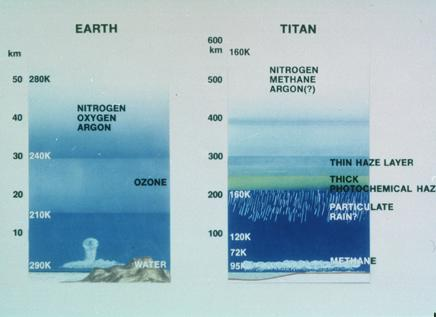The average surface temperature on Titan is −179 °C. The methane in its atmosphere causes a substantial greenhouse effect and keeps Titan at a higher temperature than it would be without it. However, haze causes an anti-greenhouse effect making it colder on Titan's surface than its upper atmosphere because it reflects sunlight back into space.
Titan is mainly made up of rocky ice and water, and it is the only other known celestial object to have liquid on its surface. Methane flows as a liquid and its lakes are vast and placid. Because of its distance from the sun (1.4 billion kilometers), it only receives 1% of the amount of sunlight Earth does. Winds transport clouds across the skies. Its surface winds are normally low, with less than 1 meter per second.
On Titan, rains only occur every few decades and it pours heavily when it does, falling on poles and pools in myriad ponds as well as vast lakes. Compared to Earth's raindrops, methane raindrops are two times larger because of the moon's low gravity and dense atmosphere and this also results in the raindrops drifting to the surface like snowflakes. Titan has seasons, similar to Earth, but they last seven Earth years and the climate is determined by the amount of sunlight it receives.
Seasonal Changes
The amount of time it takes for Saturn to complete an orbit is about 29.5 Earth years. Titan's seasonal change is determined by Saturn's orbit because during different phases of Saturn's orbit, it changes Titan's exposure to sunlight in the northern and southern hemispheres. In the northern hemisphere during the winter, because of changing atmospheric circulation, there are larger hydrocarbon lakes and decreased haze around the equinoxes.
In the summer when Titan's southern hemisphere is about 12% closer to the sun, it results in summers of the southern hemisphere being hotter and shorter than the summers in the northern hemisphere. Topological asymmetry may be a factor in contributing to this, due to the northern hemisphere having a larger amount of hydrocarbon lakes. Titan does not have any cyclones, tornadoes or moonquakes, but during the summers, the polar regions experience "Texas-like thunderstorms".
Atmosphere:
 Titan is the only moon known to have a dense atmosphere. Even though it only rains every few decades, the presence of rain indicates that rainbows could potentially form, it being the only celestial body in the Solar System with this ability aside from Earth. But because of the opacity of the atmosphere, most rainbows would only be visible in the infrared.
Titan is the only moon known to have a dense atmosphere. Even though it only rains every few decades, the presence of rain indicates that rainbows could potentially form, it being the only celestial body in the Solar System with this ability aside from Earth. But because of the opacity of the atmosphere, most rainbows would only be visible in the infrared.
Its atmosphere is made up of 95% nitrogen, 5% methane and small amounts of carbon-rich compounds. The air pressure is one and a half times that of Earth. Titan's gravity is than Earth's by almost 9 times because Earth is a larger celestial body than Titan. This also causes the atmosphere to have an altitude 10 times higher than Earth's.
In the atmosphere, methane and nitrogen molecules are divided by the sun's ultraviolet light and the splitting and reforming create a variety of elements important to life on Earth, such as carbon, hydrogen, nitrogen and oxygen.
The atmosphere is unbreathable but you would just need a breathing mask instead of a pressurized space suit and warm clothes. Check out our Titan Clothing Line to prepare for your trip!
Seasonal Changes
The amount of time it takes for Saturn to complete an orbit is about 29.5 Earth years. Titan's seasonal change is determined by Saturn's orbit because during different phases of Saturn's orbit, it changes Titan's exposure to sunlight in the northern and southern hemispheres. In the northern hemisphere during the winter, because of changing atmospheric circulation, there are larger hydrocarbon lakes and decreased haze around the equinoxes.
In the summer when Titan's southern hemisphere is about 12% closer to the sun, it results in summers of the southern hemisphere being hotter and shorter than the summers in the northern hemisphere. Topological asymmetry may be a factor in contributing to this, due to the northern hemisphere having a larger amount of hydrocarbon lakes. Titan does not have any cyclones, tornadoes or moonquakes, but during the summers, the polar regions experience "Texas-like thunderstorms".
Atmosphere:
Its atmosphere is made up of 95% nitrogen, 5% methane and small amounts of carbon-rich compounds. The air pressure is one and a half times that of Earth. Titan's gravity is than Earth's by almost 9 times because Earth is a larger celestial body than Titan. This also causes the atmosphere to have an altitude 10 times higher than Earth's.
In the atmosphere, methane and nitrogen molecules are divided by the sun's ultraviolet light and the splitting and reforming create a variety of elements important to life on Earth, such as carbon, hydrogen, nitrogen and oxygen.
The atmosphere is unbreathable but you would just need a breathing mask instead of a pressurized space suit and warm clothes. Check out our Titan Clothing Line to prepare for your trip!


